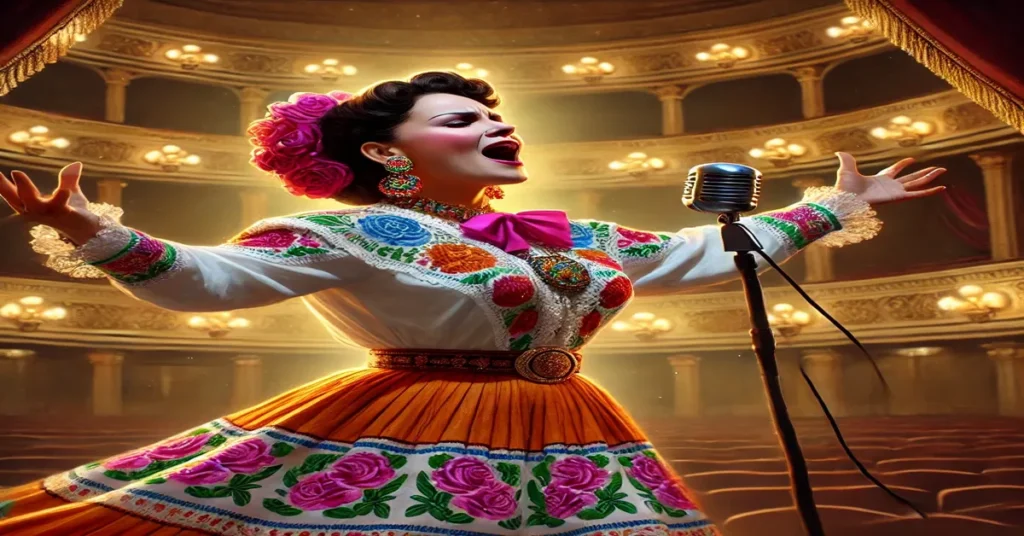Lola Beltrán, born María Lucila Beltrán Ruiz, stands as an unforgettable figure in the world of Mexican ranchera music. Known for her powerful voice and emotional depth, Beltrán played a pivotal role in popularizing Mexican folk music on an international stage. Often referred to as “La Reina de la Música Ranchera” (The Queen of Ranchera Music), her legacy continues to inspire audiences worldwide.
The Early Life of Lola Beltrán
Humble Beginnings
Born on March 7, 1932, in Rosario, Sinaloa, Mexico, Beltrán grew up in a family that instilled in her a deep love for music. Her early exposure to traditional Mexican music in a rural setting allowed her to develop a natural, authentic connection with the art form.
First Steps in Music
Beltrán’s journey to stardom wasn’t easy. Determined to break into the world of music, she left her hometown and moved to Mexico City. Working as a secretary at the Mexican radio station XEW, she seized an opportunity to audition, ultimately capturing the attention of industry icons like Emilio Azcárraga and renowned producer Felipe Valdés Leal.
Rise to Fame: The Early Career of Lola Beltrán
Breakthrough with “Cucurrucucú Paloma”
Beltrán’s rendition of the classic ranchera song “Cucurrucucú Paloma” catapulted her into the spotlight. Her vocal interpretation, marked by emotional depth and technical precision, turned the song into an instant classic. Audiences resonated with her ability to convey profound feelings, which cemented her place as a ranchera music icon.
Signature Style and Voice
Lola Beltrán was known for her vibrant stage presence and remarkable vocal control, which allowed her to imbue each song with deep feeling. Her voice carried a unique blend of strength and tenderness, embodying both the resilience and emotional depth associated with ranchera music.
Iconic Works and Major Collaborations
Key Songs
Throughout her career, Beltrán created some of the most memorable ranchera music, including timeless pieces like:
- “Cucurrucucú Paloma” – Her most recognized song, showcasing the raw emotional power of her voice.
- “La Cigarra” – Another classic that highlighted her ability to convey sorrow and hope.
- “Paloma Negra” – A deeply emotive piece about love and heartbreak that resonated across generations.
Collaborations with Industry Greats
Beltrán collaborated with various well-known artists, including Vicente Fernández and Javier Solís, further enhancing her influence in the music industry. She also worked with prominent composers, such as José Alfredo Jiménez, whose songs provided a perfect foundation for her distinctive voice and style.
Impact on Mexican Culture and Identity
A Cultural Icon
Lola Beltrán was more than a singer; she was a cultural symbol for Mexicans, both domestically and abroad. Her performances often reflected themes central to Mexican culture, such as love, heartbreak, pride, and patriotism. Her work was not only celebrated in Mexico but was also embraced by the Mexican diaspora, making her a unifying figure.
International Reach
Beltrán’s appeal crossed borders, as she performed in venues worldwide, including the United States, Spain, and Argentina. Her international recognition helped elevate Mexican music on the global stage, promoting cultural exchange and fostering appreciation for ranchera music beyond Mexico.
The Evolution of Lola Beltrán’s Career
Transition to Film and Television
Beltrán’s career extended beyond music; she appeared in over 50 films, solidifying her status as a versatile entertainer. Movies like La Feria de San Marcos and Canción de Mi Pueblo showcased her ability to connect with audiences both as a singer and actress.
Television Appearances and Lasting Legacy
In later years, she hosted Noches Tapatías, a popular Mexican television show celebrating Mexican music and culture. Her role on television allowed her to reach new audiences, further endearing her to fans across generations.
Challenges and Triumphs: Lola Beltrán’s Personal Journey
Breaking Gender Barriers
Lola Beltrán’s career was marked by her role as a pioneering female figure in a male-dominated genre. Despite facing numerous challenges, she remained committed to her craft, becoming one of the first women to achieve mainstream success in ranchera music. Her success paved the way for future generations of female artists in Mexican folk music.
Enduring Popularity and Personal Struggles
While Beltrán enjoyed an illustrious career, she faced personal struggles as well. Her life in the public eye brought challenges, but she continued to perform with passion and dedication. Her resilience remains an inspiration to aspiring musicians who look up to her legacy.
Legacy and Influence in Contemporary Music
Tribute Performances and Covers
After her death on March 24, 1996, many artists paid tribute to Beltrán by covering her songs. Her influence is seen in the works of contemporary Latin American artists like Lila Downs and Natalia Lafourcade, who continue to keep her spirit alive through music.
Lola Beltrán’s Influence on Future Generations
Today, Lola Beltrán’s influence extends to modern Mexican and Latin American music. Her legacy continues to inspire artists across genres, from mariachi to Latin pop. Young artists often cite her as a role model, as she embodies the power of authenticity and emotional depth in music.
Conclusion: Remembering La Reina de la Música Ranchera
Lola Beltrán’s story is one of resilience, passion, and timeless artistry. From humble beginnings to international fame, she remains an iconic figure who has shaped the trajectory of Mexican music. Her contributions to ranchera music have left an indelible mark on the world, and her legacy endures as new generations discover and celebrate her music.
FAQs
What made Lola Beltrán’s voice unique?
Her voice was known for its powerful range and ability to convey deep emotion, making her performances resonate with audiences worldwide.
How did Lola Beltrán get her start in the music industry?
Beltrán began working at a Mexican radio station, XEW, as a secretary. She later auditioned and impressed producers, launching her music career.
Which of Lola Beltrán’s songs became the most iconic?
“Cucurrucucú Paloma” is her most famous song, loved for its emotional depth and technical beauty.
How did Lola Beltrán impact Mexican culture?
Beltrán became a symbol of Mexican pride and heritage, embodying themes of love, patriotism, and resilience that resonated deeply with Mexican audiences.
Did Lola Beltrán perform outside of Mexico?
Yes, she performed internationally, including in the United States and Spain, helping to popularize Mexican music globally.
What is Lola Beltrán’s legacy in the world of music?
Her influence endures as she inspires new generations of musicians who admire her authenticity, resilience, and dedication to Mexican culture.
4o







